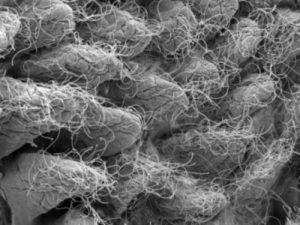The possibilities are exciting. See my earlier posts on psychobiotics for more information. From Medical Xpress:
How gut bacteria ensures a healthy brain – and could play a role in treating depression
But medicine in the 21st century is rethinking its relationship with bacteria and concluding that, far from being uniformly bad for us, many of these organisms are actually essential for our health. Nowhere is this more apparent than in the human gut, where the microbiome – the collection of bacteria living in the gastrointestinal tract - plays a complex and critical role in the health of its host.
The microbiome interacts with and influences organ systems throughout the body, including, as research is revealing, the brain. This discovery has led to a surge of interest in potential gut-based treatments for neuropsychiatric disorders and a new class of studies investigating how the gut and its microbiome affect both healthy and diseased brains.
The lives of the bacteria in our gut are intimately entwined with our immune, endocrine and nervous systems. The relationship goes both ways: the microbiome influences the function of these systems, which in turn alter the activity and composition of the bacterial community. We are starting to unravel this complexity and gain insight into how gut bacteria interface with the rest of the body and, in particular, how they affect the brain.
The microbiome-immune system link is established early on. Over the first year of life, bacteria populate the gut, which is largely sterile at birth, and the developing immune system learns which bacteria to consider normal residents of the body and which to attack as invaders. This early learning sets the stage for later immune responses to fluctuations in the microbiome's composition.
When a normally scarce strain becomes too abundant or a pathogenic species joins the community of gut bacteria, the resulting response by the immune system can have wide-reaching effects. Depression has been linked with elevated levels of such molecules in some individuals, suggesting that treatments that alter the composition of the microbiome could alleviate symptoms of this disorder.
Such an intervention could potentially be achieved using either prebiotics – substances that promote the growth of beneficial bacteria – or probiotics – live cultures of these bacteria. It is even possible that the microbiome could be manipulated by dietary changes.
In one experiment, researchers transplanted the human microbiome into germ-free mice (animals that have no gut bacteria) in order to study it in a controlled setting. They found that, simply by changing the carbohydrate and fat content of the mice's food, they could alter basic cellular functions and gene expression in the microbiome.
Depression is not the only psychiatric disorder in which the microbiome may play a role.Research in rodents, as well as a few preliminary studies in humans, indicate that the state of our resident microbes is tied to our anxiety levels.
This research also reveals the complexity of the relationship between the microbiome and psychological state. ...Researchers have shown that the presence or absence of microbes in young mice affects the sensitivity of the hypothalamic-pituitary-adrenal (HPA) axis – a key pathway in the body's stress response system. The activity of the microbiome during development thus sways how we respond to future stressors and how much anxiety they cause us.
How do the bacteria in our gut wield such influence over our brains and bodies? The mechanisms of microbiome-host interactions appear to be as numerous and varied as the interactions themselves.

 Very exciting new way to use probiotics! Huge potential. From Science Daily:
Very exciting new way to use probiotics! Huge potential. From Science Daily: Human lungs. Credit: Wikipedia
Human lungs. Credit: Wikipedia Finally, a discussion of the eye microbiome or microbiota (microbial community). Originally eyes were thought not to have much microbial life. But now with modern technology (such as genetic sequencing) it is known that many microbial species live on the eye. And yes, the eye or ocular microbiome can become imbalanced.
Finally, a discussion of the eye microbiome or microbiota (microbial community). Originally eyes were thought not to have much microbial life. But now with modern technology (such as genetic sequencing) it is known that many microbial species live on the eye. And yes, the eye or ocular microbiome can become imbalanced. More long-standing medical advice goes out the window. New advice: avoid diet soda and artificial sweeteners. The amazing part is that our gut bacteria are involved.
More long-standing medical advice goes out the window. New advice: avoid diet soda and artificial sweeteners. The amazing part is that our gut bacteria are involved. This image depicts gut microbiota.
This image depicts gut microbiota.